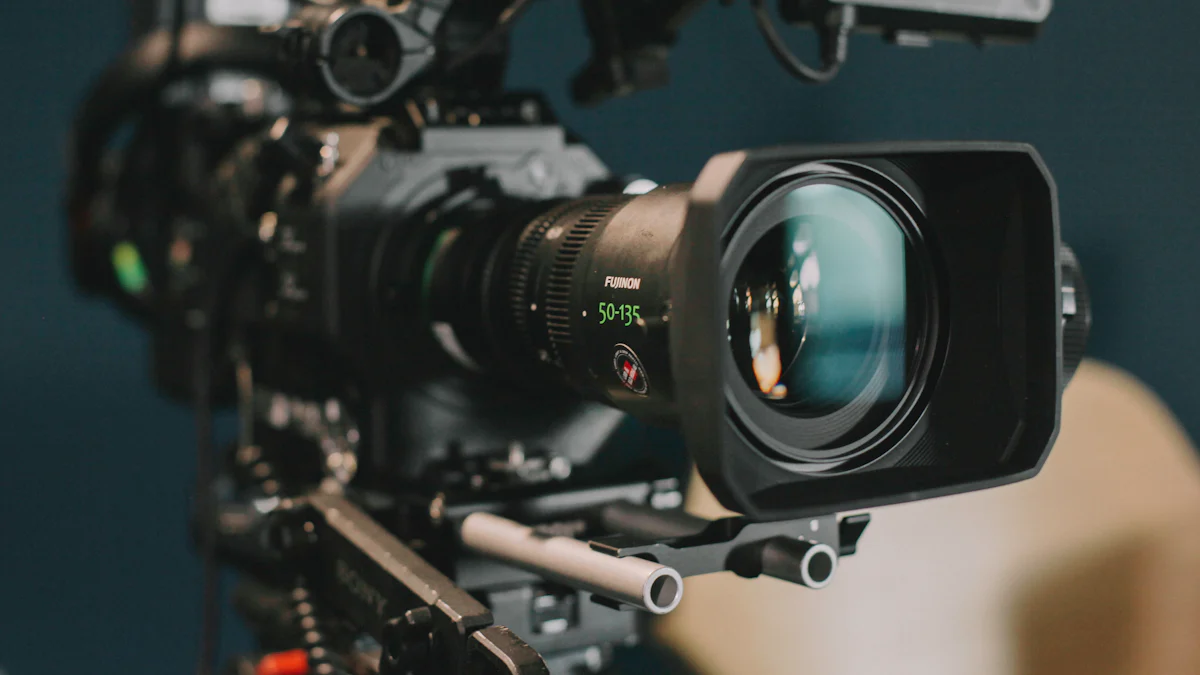AI Video Content Generators: A How-To for Marketers

AI video content generators have emerged as a game-changer in the marketing world. Video content holds immense importance for marketers, with 96% of marketers recognizing it as a crucial component of their strategy. AI revolutionizes video content creation by automating tasks, enhancing creativity, and improving audience engagement. AI-driven tools streamline workflows, save time, and offer personalized content at scale. These advancements make video production more efficient and accessible, allowing businesses to connect with their audience through compelling visuals and stories.
Understanding AI Video Content Generators
What Are AI Video Content Generators?
Definition and Explanation
AI video content generators are advanced tools that leverage machine learning algorithms to automate the creation of video content. These tools analyze vast datasets, including images, videos, and text, to produce visually appealing and coherent videos. By automating repetitive tasks such as editing, transitions, and effects, AI video content generators streamline the video production process. This technology enables businesses to create high-quality videos without requiring advanced technical skills.
Key Features and Capabilities
AI video content generators offer several key features and capabilities:
-
Automated Editing: Tools like Invideo's AI assist in video editing and template selection, making the creation process faster.
-
Customization: AI tailors video content to specific marketing requirements, enhancing engagement and message effectiveness.
-
Real-Time Personalization: AI allows businesses to dynamically update video content based on user interactions or changing market trends.
-
Efficiency: AI processes large volumes of video content quickly, identifying patterns and key moments to develop relevant content.
Benefits for Marketers
Time and Cost Efficiency
AI video content generators significantly reduce the time and effort required in the video creation process. By automating repetitive tasks, these tools allow marketers to focus on strategy and creativity. AI-driven platforms generate video content on a large scale, presenting cost-effective solutions for marketing departments. Businesses can produce engaging videos in minutes, making video production more efficient than traditional methods.
Enhanced Creativity and Customization
AI enhances creativity by providing intelligent design suggestions and automatically adapting templates to specific needs. Marketers can create personalized and targeted videos that resonate with their audience. AI-powered tools enable real-time personalization, allowing businesses to dynamically update video content. This level of customization helps brands connect with their audience on a more individual level.
Improved Audience Engagement
AI video content generators optimize engagement by tailoring video content to the target audience. AI analyzes data and user preferences to create videos that captivate viewers. Businesses can deliver personalized and targeted videos, maximizing reach and customer conversion rates. AI-generated videos can be optimized for various platforms and devices, enhancing content effectiveness across different channels.
Popular AI Video Content Generation Tools
Overview of Leading Tools
Tool 1: Features and Benefits
Clip Creator stands out as a versatile AI video content generator. This tool offers automated editing, which simplifies the video creation process. Users can select from a variety of templates tailored to different marketing needs. Clip Creator also provides real-time personalization, allowing businesses to update video content dynamically. The tool's efficiency in processing large volumes of data ensures that marketers can produce high-quality videos quickly.
Tool 2: Features and Benefits
DeepBrain AI excels in creating engaging video content through advanced machine learning algorithms. This AI video content generator analyzes user preferences to deliver personalized videos. DeepBrain AI supports multiple languages, making it ideal for global marketing campaigns. The tool's customization options enable marketers to create unique and targeted videos that resonate with specific audiences. DeepBrain AI also offers seamless integration with various social media platforms, enhancing content distribution.
Tool 3: Features and Benefits
Invideo is another powerful AI video content generator known for its user-friendly interface. Invideo assists users in selecting templates and automating the editing process. The tool provides intelligent design suggestions, enhancing creativity and customization. Invideo's real-time analytics feature helps marketers track video performance and make necessary adjustments. The platform's extensive library of stock footage and music further aids in creating compelling video content.
Comparison of Tools
Pricing
-
Clip Creator: Offers a tiered pricing model, starting with a basic plan suitable for small businesses. Advanced plans cater to larger enterprises with more extensive needs.
-
DeepBrain AI: Provides flexible pricing options based on usage and features required. Custom plans are available for large-scale marketing campaigns.
-
Invideo: Features a subscription-based pricing structure. Free trials allow users to explore the tool's capabilities before committing to a paid plan.
Usability
-
Clip Creator: Known for its intuitive interface, making it accessible to users with varying levels of technical expertise.
-
DeepBrain AI: Offers a comprehensive tutorial and customer support, ensuring users can maximize the tool's potential.
-
Invideo: Boasts a straightforward design, enabling users to create videos with minimal effort. The platform includes drag-and-drop functionality for ease of use.
Integration with Other Marketing Tools
-
Clip Creator: Integrates seamlessly with popular marketing tools such as HubSpot and Mailchimp. This integration streamlines workflows and enhances marketing strategies.
-
DeepBrain AI: Compatible with various CRM systems and social media platforms. This compatibility facilitates efficient content distribution and audience engagement.
-
Invideo: Supports integration with numerous third-party applications, including Google Analytics and Facebook Ads. These integrations provide valuable insights into video performance and audience behavior.
How to Implement AI Video Content Generators in Your Marketing Strategy
Identifying Your Video Content Needs
Audience Analysis
Understanding the target audience is crucial for effective video marketing. Marketers should analyze demographic data, interests, and behaviors to tailor content. This analysis helps in creating videos that resonate with viewers. AI video content generators can assist by analyzing large datasets to identify audience preferences.
Content Goals
Setting clear content goals is essential for any marketing strategy. Goals may include increasing brand awareness, driving traffic, or boosting sales. Defining these objectives helps in selecting the right type of video content. AI video content generators can create various types of videos, such as explainer videos, tutorials, or promotional clips, to meet specific goals.
Choosing the Right Tool
Factors to Consider
Selecting the appropriate AI video content generator involves considering several factors:
-
Features: Evaluate the tool's capabilities, such as automated editing, customization options, and real-time personalization.
-
Usability: Ensure the tool has an intuitive interface that suits the team's technical expertise.
-
Integration: Check if the tool integrates with existing marketing platforms like CRM systems and social media channels.
-
Cost: Compare pricing models to find a tool that fits the budget without compromising on essential features.
Trial and Testing
Before committing to a tool, conduct trials and tests. Many AI video content generators offer free trials or demo versions. Use these opportunities to explore the tool's functionalities. Test the tool by creating sample videos and assessing their quality and effectiveness. Gather feedback from team members to make an informed decision.
Creating Your First AI-Generated Video
Step-by-Step Guide
-
Select a Template: Choose a template that aligns with the content goals. Most AI video content generators provide a variety of templates.
-
Upload Assets: Add images, videos, and text that will be used in the video. The tool will analyze these assets to create a coherent video.
-
Customize Content: Use the tool's customization features to tailor the video. Adjust colors, fonts, and transitions to match the brand identity.
-
Automate Editing: Allow the AI to automate repetitive tasks like editing and adding effects. This step saves time and ensures consistency.
-
Preview and Edit: Review the generated video and make any necessary adjustments. Fine-tune elements to enhance the video's appeal.
-
Export and Share: Once satisfied with the video, export it in the desired format. Share the video across various platforms to reach the target audience.
Tips for Optimization
Optimizing AI-generated videos can maximize their impact:
-
Engaging Thumbnails: Create eye-catching thumbnails to attract viewers.
-
Captions and Subtitles: Add captions and subtitles to make videos accessible and improve engagement.
-
Call-to-Action: Include clear calls-to-action to guide viewers on the next steps.
-
Platform-Specific Adjustments: Tailor videos for different platforms, considering aspect ratios and length requirements.
-
Performance Tracking: Use analytics tools to monitor video performance and gather insights for future improvements.
Measuring Success and ROI
Key Metrics to Track
Marketers must track specific metrics to measure the success of AI-generated video content. These metrics provide insights into the effectiveness of video marketing efforts.
-
View Count: The number of times a video gets viewed indicates its reach and popularity.
-
Engagement Rate: This metric includes likes, shares, and comments. High engagement rates suggest that the content resonates with the audience.
-
Watch Time: The total time viewers spend watching the video. Longer watch times indicate higher viewer interest and content quality.
-
Click-Through Rate (CTR): The percentage of viewers who click on links or calls-to-action within the video. A high CTR shows effective content in driving desired actions.
-
Conversion Rate: The percentage of viewers who complete a specific action, such as signing up for a newsletter or making a purchase. This metric directly ties video content to business goals.
-
Bounce Rate: The percentage of viewers who leave the video shortly after starting it. A low bounce rate indicates engaging content.
Analyzing Results and Making Adjustments
Analyzing these metrics helps marketers understand the performance of their AI-generated videos. This analysis enables data-driven decisions to optimize future content.
-
Identify Patterns: Look for trends in the data. For example, if videos with certain themes or formats perform better, focus on creating similar content.
-
Audience Feedback: Use comments and direct feedback to gauge audience reactions. Positive feedback highlights successful elements, while negative feedback points to areas for improvement.
-
A/B Testing: Experiment with different versions of videos to see which performs better. Test variables like video length, style, and calls-to-action.
-
Adjust Content Strategy: Based on the analysis, refine the video content strategy. Focus on what works and eliminate what doesn't.
-
Monitor Competitors: Keep an eye on competitors' video content. Learn from their successes and mistakes to improve your own strategy.
"AI provides powerful tools and insights to create engaging and personalized content, transforming the way videos are produced, distributed, and analyzed." - Businesses
Regularly reviewing these metrics ensures that AI-generated video content remains effective and aligned with marketing goals. By continuously optimizing based on data, marketers can maximize the return on investment (ROI) from their video marketing efforts.
AI video content generators offer numerous benefits for marketers. These tools streamline video production, enhance creativity, and improve audience engagement. The steps for using AI video content generators include identifying content needs, choosing the right tool, and creating optimized videos.
"85% of marketers believe generative AI will change content creation in 2024."
The future of AI in video marketing looks promising. AI will continue to evolve, providing more advanced features and capabilities. Marketers should start experimenting with AI tools to stay ahead of the curve and maximize their marketing efforts.
See Also
Effective Strategies for Quick Content Creation: A Creator's Update
Top 5 AI Tools for Content Creation Competing with Scalenut
Optimizing Viewer Interaction Using TikTok Data Tools: A Guide

